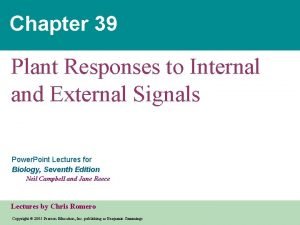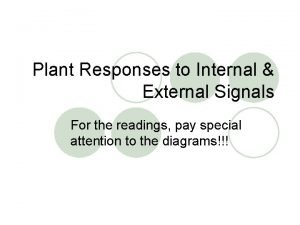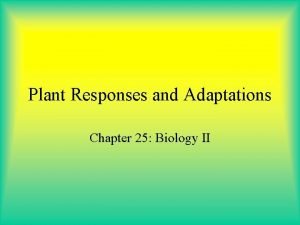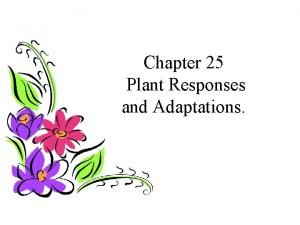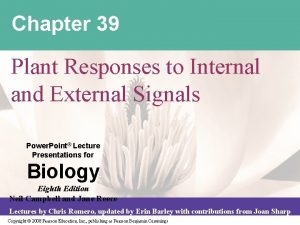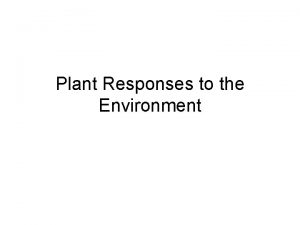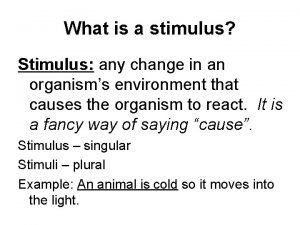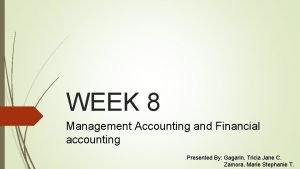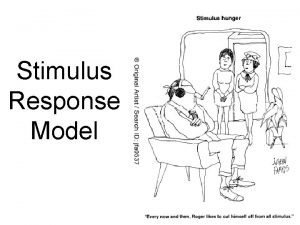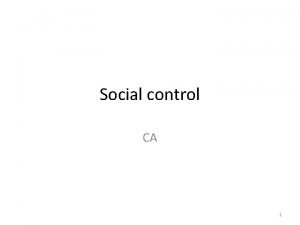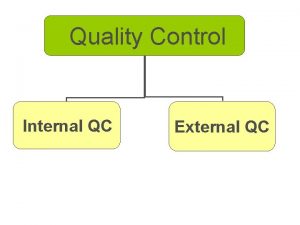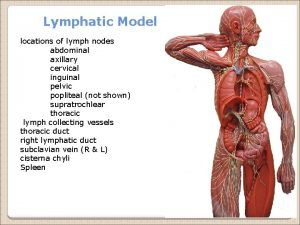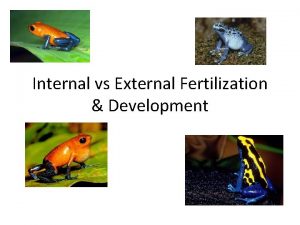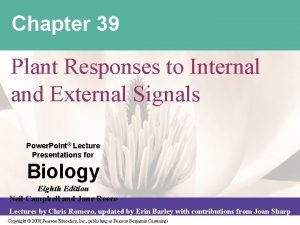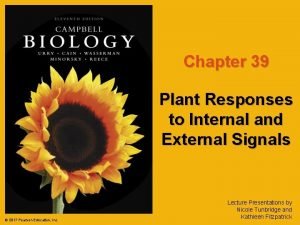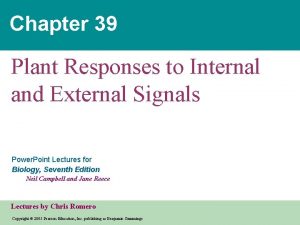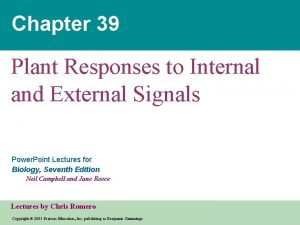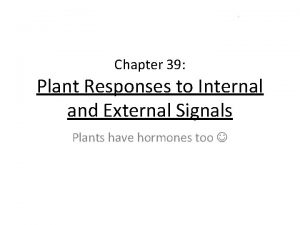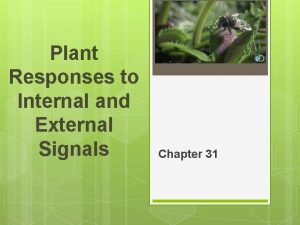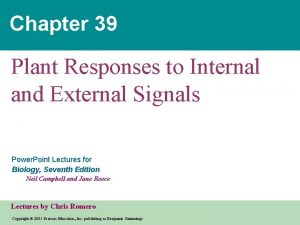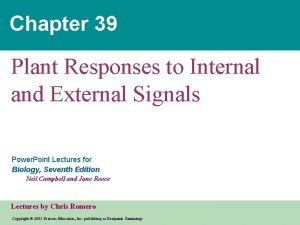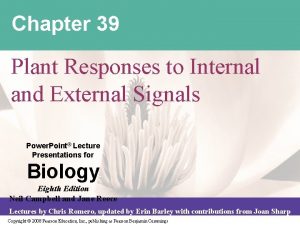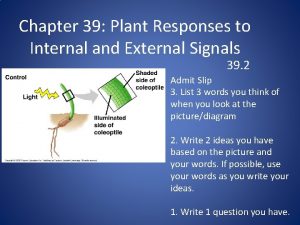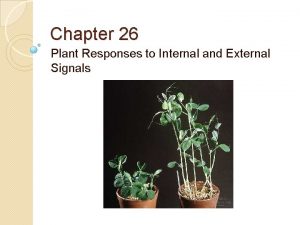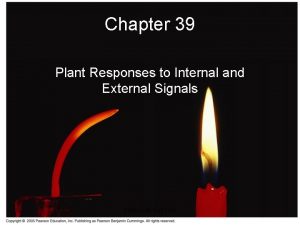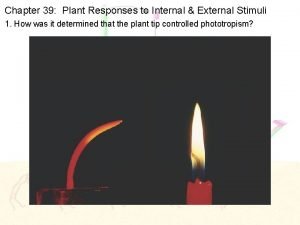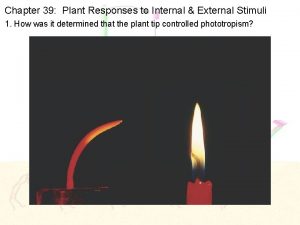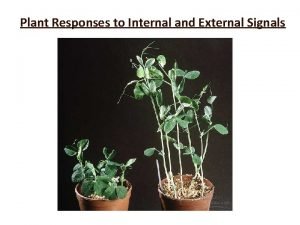Chapter 39 Plant Responses to Internal and External
























- Slides: 24

Chapter 39 Plant Responses to Internal and External Signals Power. Point Lectures for Biology, Seventh Edition Neil Campbell and Jane Reece Lectures by Chris Romero Copyright © 2005 Pearson Education, Inc. publishing as Benjamin Cummings

LE 39 -2 Before exposure to light. A dark-grown potato has tall, spindly stems and nonexpanded leaves— morphological adaptations that enable the shoots to penetrate the soil. The roots are short, but there is little need for water absorption because little water is lost by the shoots. After a week’s exposure to natural daylight. The potato plant begins to resemble a typical plant with broad green leaves, short sturdy stems, and long roots. This transformation begins with the reception of light by a specific pigment, phytochrome.

• In the late 1800 s, Charles Darwin and his son Francis conducted experiments on phototropism, a plant’s response to light • They observed that a seedling could bend toward light only if the tip of the coleoptile was present • They postulated that a signal was transmitted from the tip to the elongating region Video: Phototropism Copyright © 2005 Pearson Education, Inc. publishing as Benjamin Cummings

LE 39 -5 a Shaded side of coleoptile Control Light Illuminated side of coleoptile

LE 39 -5 b Darwin and Darwin (1880) Light Tip removed covered by opaque cap Base covered Tip covered by opaque by trans- shield parent cap

LE 39 -5 c Boysen-Jensen (1913) Light Tip separated by by mica gelatin block

• In 1926, Frits Went extracted the chemical messenger for phototropism, auxin, by modifying earlier experiments Copyright © 2005 Pearson Education, Inc. publishing as Benjamin Cummings

LE 39 -6 Excised tip placed on agar block Growth-promoting chemical diffuses into agar block Control (agar block lacking chemical) has no effect Agar block with chemical stimulates growth Offset blocks cause curvature

A Survey of Plant Hormones • In general, hormones control plant growth and development by affecting the division, elongation, and differentiation of cells Copyright © 2005 Pearson Education, Inc. publishing as Benjamin Cummings

Copyright © 2005 Pearson Education, Inc. publishing as Benjamin Cummings

Control of Cell Division and Differentiation • Cytokinins are produced in actively growing tissues such as roots, embryos, and fruits • Cytokinins work together with auxin

Control of Apical Dominance • Cytokinins, auxin, and other factors interact in the control of apical dominance, a terminal bud’s ability to suppress development of axillary buds Copyright © 2005 Pearson Education, Inc. publishing as Benjamin Cummings

LE 39 -9 Axillary buds “Stump” after removal of apical bud Lateral branches Intact plant Plant with apical bud removed

Leaf Abscission • A change in the balance of auxin and ethylene controls leaf abscission, the process that occurs in autumn when a leaf falls 0. 5 mm Protective layer Copyright © 2005 Pearson Education, Inc. publishing as Benjamin Cummings Stem Abscission layer Petiole

Fruit Ripening • A burst of ethylene production in a fruit triggers the ripening process Copyright © 2005 Pearson Education, Inc. publishing as Benjamin Cummings

Biological Clocks and Circadian Rhythms • Many plant processes oscillate during the day • Many legumes lower their leaves in the evening and raise them in the morning Noon Copyright © 2005 Pearson Education, Inc. publishing as Benjamin Cummings Midnight

• Cyclical responses to environmental stimuli are called circadian rhythms and are about 24 hours long • Circadian rhythms can be entrained to exactly 24 hours by the day/night cycle Copyright © 2005 Pearson Education, Inc. publishing as Benjamin Cummings

Photoperiodism and Responses to Seasons • Photoperiod, the relative lengths of night and day, is the environmental stimulus plants use most often to detect the time of year • Photoperiodism is a physiological response to photoperiod

LE 39 -22 Darkness 24 hours Flash of light Critical dark period Light “Short-day” plants “Long-day” plants

Gravity • Response to gravity is known as gravitropism • Roots show positive gravitropism • Stems show negative gravitropism Copyright © 2005 Pearson Education, Inc. publishing as Benjamin Cummings

• Plants may detect gravity by the settling of statoliths, specialized plastids containing dense starch grains Video: Gravitropism Copyright © 2005 Pearson Education, Inc. publishing as Benjamin Cummings

LE 39 -25 Statoliths 20 µm

• Thigmotropism • Rapid leaf movements in response to mechanical stimulation are examples of transmission of electrical impulses called action potentials Video: Mimosa Leaf Copyright © 2005 Pearson Education, Inc. publishing as Benjamin Cummings

LE 39 -27 Unstimulated Side of pulvinus with flaccid cells Leaflets after stimulation Side of pulvinus with turgid cells Vein Pulvinus (motor organ) Motor organs 0. 5 mm
 Seed germination
Seed germination Plant responses to internal and external signals
Plant responses to internal and external signals Chapter 25 plant responses and adaptations answer key
Chapter 25 plant responses and adaptations answer key Chapter 25 plant responses and adaptations answer key
Chapter 25 plant responses and adaptations answer key Plant hormones and responses
Plant hormones and responses Plant hormones and responses
Plant hormones and responses The stationary life
The stationary life Accounting information system chapter 1
Accounting information system chapter 1 Chapter 10 stress responses and stress management
Chapter 10 stress responses and stress management Parts of the plants and function
Parts of the plants and function Geotropism positive and negative
Geotropism positive and negative Internal users of accounting
Internal users of accounting Internal and external stakeholders examples
Internal and external stakeholders examples Examples of external stimuli
Examples of external stimuli Formal social control
Formal social control Internal and external factors of nationalism
Internal and external factors of nationalism Reliability test in research
Reliability test in research Internal vs external qc
Internal vs external qc Blood bank qc
Blood bank qc Stakeholders internal and external
Stakeholders internal and external Internal naris
Internal naris Objective of quality
Objective of quality Interrupt priority register in 8051
Interrupt priority register in 8051 Birds
Birds Internal hardware components of a computer
Internal hardware components of a computer
